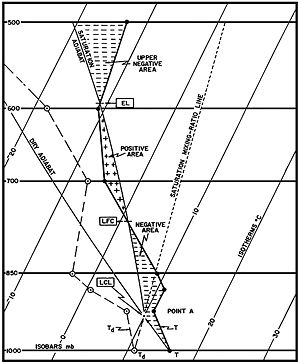Convective inhibition
In most cases, when CIN exists, it covers a layer from the ground to the level of free convection (LFC).Convective inhibition indicates the amount of energy that will be required to force the cooler packet of air to rise.Typically, an area with a high convection inhibition number is considered stable and has very little likelihood of developing a thunderstorm.CIN hinders updrafts necessary to produce convective weather, such as thunderstorms.Surface cooling causes a small capping inversion to form aloft allowing the air to become stable.Incoming weather fronts and short waves influence the strengthening or weakening of CIN.The z-bottom and z-top limits of integration in the equation represent the bottom and top altitudes (in meters) of a single CIN layer,
meteorologyair parcellevel of free convectionmesoscaleorographic liftthunderstormadvectionweather frontsshort wavesRawinsondeweather balloontemperaturepressurevirtual temperaturejoulesconvectionskew-T log-P diagrambuoyancyconvective available potential energy (CAPE)Atmospheric thermodynamicsConvective instabilityEquilibrium levelThermodynamic diagramsBibcodeAdiabatic processesLapse rateLightningSurface solar radiationSurface weather analysisVisibilityVorticityWind shearCondensationCloud condensation nuclei (CCN)Convective condensation level (CCL)Lifting condensation level (LCL)Precipitable waterPrecipitationWater vaporConvective momentum transportConditional symmetric instabilityConvective temperature (Tc)Equilibrium level (EL)Free convective layer (FCL)K IndexLevel of free convection (LFC)Lifted index (LI)Maximum parcel level (MPL)Bulk Richardson number (BRN)Dew point (Td)Dew point depressionDry-bulb temperatureEquivalent temperature (Te)Forest fire weather indexHaines IndexHeat indexHumidexHumidityRelative humidity (RH)Mixing ratioPotential temperature (θ)Equivalent potential temperature (θe)Sea surface temperature (SST)Temperature anomalyThermodynamic temperatureVapor pressureWet-bulb temperatureWet-bulb globe temperatureWet-bulb potential temperatureWind chillAtmospheric pressureBaroclinityBarotropicityPressure gradientPressure-gradient force (PGF)VelocityMaximum potential intensity